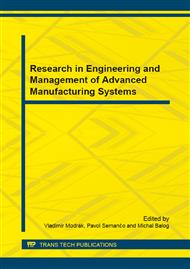p.88
p.93
p.99
p.105
p.110
p.116
p.122
p.131
p.137
The Comparison of Durability Ceramic Cutting Tools in Turning Process of Steel 80MoCrV4016
Abstract:
Every experiment has inputs and outputs. Inputs are defined before experiment and they are accurately determined and described. Outputs have to be measured and described after experiment. It is very difficult to describe and express parameters that are base of experiments. Tested parameters and theirs dependencies are very often described by means of graphs, tables or definitions. Lot of parameters and their dependencies in engineering practice are not described by means of formula. Very important and often used standard ISO in engineering practice is standard ISO 3685. This standard includes characteristics for various cutting materials. The main part of this standard is T-vc dependence for cutting materials. One of the cutting materials contained in standard ISO 3685 is cutting ceramic. There are instructions obtained in standard ISO 3685 for creation of T-vc dependence. Specification cutting tools durability made of cutting ceramic in machining process of steel 80MoCrV4016 is very important for economics of small and medium-sized enterprises, because cutting tool durability is factor that significantly affects the budget of these enterprises. This problematic is determined for small and medium-sized manufacturers of bearings, because steel 80MoCrV4016 is most commonly used for production of bearings. Durability of cutting tool defines lifetime of this cutting tool and it determines its suitability for select technological operation. The article describes process how to create durability dependence for cutting tools made of cutting ceramic by means of T-vc dependence in machining process of steel 80MoCrV4016.
Info:
Periodical:
Pages:
110-115
Citation:
Online since:
December 2014
Keywords:
Price:
Сopyright:
© 2015 Trans Tech Publications Ltd. All Rights Reserved
Share:
Citation:


